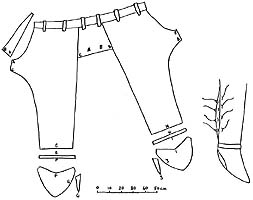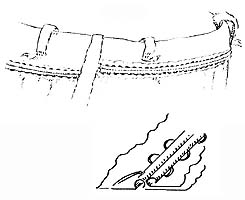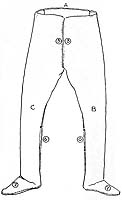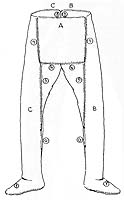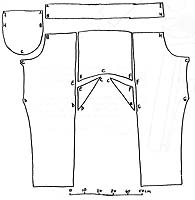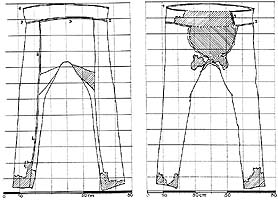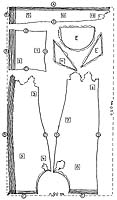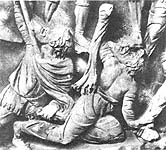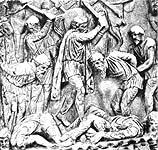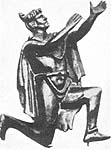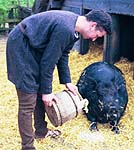 |
||||||||||||
|
Lesson #4: Page 3
Some continental pictorial representations often show them to be rather loose; the slack material was gathered round the waist and it hung in folds around the legs. However, the examples known from archaeology are all much more closely fitting, more akin to the tight fitting leg coverings shown in later Anglo-Saxon manuscripts and some of the sixth and seventh century decorative panels from helmets from England and Scandinavia. It seems that whether the trousers were tight or loose was largely a matter of personal choice or tribal tradition, but tighter trousers were probably more common in Anglo-Saxon England. It is interesting to note that, in contrast to the simply shaped outer garments such as cloaks, tunics and women's gowns, the trousers are tailored to give a good fit whilst wasting a minimum amount of fabric. Click on image for larger version in new window
Four bogs from South Denmark and North Germany have yielded finds of trousers - Thorsberg, Damendorf, Daetgen and Marx-Etzel. The rich votive offerings from Thorsberg (probably the most famous of the four) yielded two pairs of trousers, one pair better preserved than the other. In the best pair one of the legs is torn off halfway down, the other terminates in a stockinged foot (not unlike a modern romper suit for a baby!) The waist of the garment is large (about 1m) although the legs are tight fitting (about 30cm at the calf). A trapezoidal-shaped piece is let into the seat, and in front a wedge-shaped inset runs from the crutch up the front of the trousers and divides the waistband. Six straps are sewn onto the waistbabd for holding a belt. Strangely enough these straps are made of roughly cut strips of cloth with neither seam, border, nor any other form of finish. The wrong side of the waistband faces outwards, perhaps because the waistband was folded over when worn, concealing the belt and belt-loops. At the ankle the seam has been left open and fitted with ties to ensure a close fit. As shown by the pattern, the cut of the trousers is carefully worked out and cannot be described as primitive, while the fabric is exceptionally well woven in fine broken diamond twill, indicating the wearer was not poor. Click on image for a larger version in a new window The second pair of trousers from Thorsberg are also footed, but are of simpler cut and a slightly looser fit, and give the impression of being not quite so high quality as the first pair. However, they are still well made and have several similarites to the first pair. Click on image for a larger version in a new window
The trousers from Damendorf are also a fine piece of clothing. The similarity in principle between them and the Thorsberg pair is very apparent although some pieces are unfortunately missing. For instance, the lower parts of the legs are torn away and it is impossible to judge wheter these once terminated in stocking feet (although this seems quite likely). Like the Thorsberg trousers, the waist is extremely wide and would hang in folds around the crutch when belted. Click on image for a larger version in a new window The trousers from Daetgen and Marx-Etzel are both shorter (about knee length). They may also be much older than the Thorsberg and Damendorf trousers. No short trousers are shown in contemporary representations, though garments like this were probably worn as a form of underwear. #1 Trousers at this time all seem to have been ankle length, with the shorter trousers probably only remaining as undergarments. Trousers were referred to as brec (short trousers) and braccas (breeches or long trousers). Leggings
First a legging proper, or stocking, made of woven fabric or leather; second a strip of fabric which could be used to tie on the leggings or confining the loose folds of the trousers (as well as covering up the ankle slit), or which could be wound around the shin and foot for warmth and protection, much like 'puttees' and probably known as strapulas or winingas. A number of such wrappings are known from bog finds, and most are quite broad, about 4-5 inches (10-12cm) wide. #3 Only one pair, from Bernuthsfeld in Germany, seem to have survived to their full lenght of 3.7m. This pair have seams in the middle, with each one being made up of two strips joined together. Most of these leg bindings are made of wool woven to the correct width, but they could also presumably be cut from wider cloth and carefully hemmed (probably with blanket stitch). Also known from archaeology are rectangles of cloth wound around the lower leg and tied in place with strings or ribbons. These may well be the gaiter like garment known as hosa, in which case the ribbons would be the hose-bend or wining known from linguistic sources. These may also have been made of leather since we know of the word leder-hosa. However, it is also likely that the word hosa could also be used for the stocking like garment (especially when considering their similarity to the later medieval leg coverings known as 'hose'), in which case the hose-bend and wining could refer to the garter holding them up. A few Anglo-Saxon men may have been in the habit of carrying their knives or tools stuck into their leggings since a few small knives and tools have been found at the lower legs of skeletons in Anglo-Saxon graves. Click on image for a larger version in a new window 1 These trousers have been identified as women's underdrawers by one author, although there is no evidence to support this. However, such trousers would have served as undergarments for either sex. back 2 These garments do not seem to be worn habitually and rarely feature in pictorial representations. They were probably worn either for warmth, or to protect the trousers (and the legs) from thorns and brambles when out in the forests. back 3 These type of leg-bindings are frequently shown in late Anglo-Saxon manuscript illustrations, but by then have become narrower and longer (modern reconstructions suggest as long as 7-9m, but only 25-40mm broad). back Page
1 | Page 2 | Page 3 | Page
4 | Page 5 | Page
6 | Page 7 | Page
8
|
||||||||||||
| Costume
Classroom is a division of The
Costume Gallery, copyright 1997-2002.
Having problems with this webpage contact: questions@costumegallery.com |
||||||||||||

